Mare Crisium 
Move your mouse over the picture to see the names of the various features.
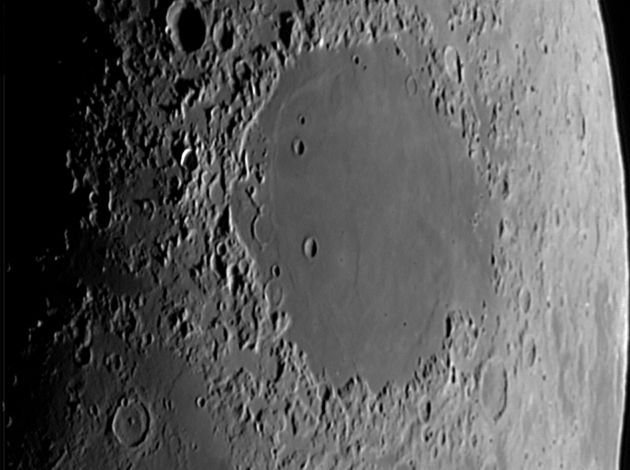
|
This is the Mare Crisium on the Moon's eastern limb. The libration is fairly favourable (5° 16' in Longitude) so the mare shows
up well. It is a roughly circular feature, 600 Km in diameter and 3,900 million years old. (Actually
it is slightly wider east-west than it is north-south.) The capes,
are more accurately named 'Promontorium' in the Latin, but 'Cape' is a much shorter word for the mouseover.
I can find no easy explanation for the very strange apparent shape of Eimmart. There seems no doubt that it
is a normal, circular crater (as shown by this image from the Clementine spacecraft).
Maybe the small crater (Eimmart A) on its eastern rim is higher than the rest of the rim and
this distorts the shadow so as to make it appear straight. Or maybe the floor has a bulge in the
middle (there appears to be no central mountain) which similarly distorts the shadow. Dr. C. A. Wood, in his book
The Modern Moon, has a picture on page 90 which shows Eimmart looking just the same. I can only assume his picture
and mine were taken at the same age of the Moon. I need to find another picture with different lighting (see below).
The scale markers are approximately 100 Km north and east.
The picture was taken at 19:01 UT on 14th March 2005 with my EXT125, when the Moon was 4.6 days old. (Other details of exposure are below the next picture.)
|
|
|
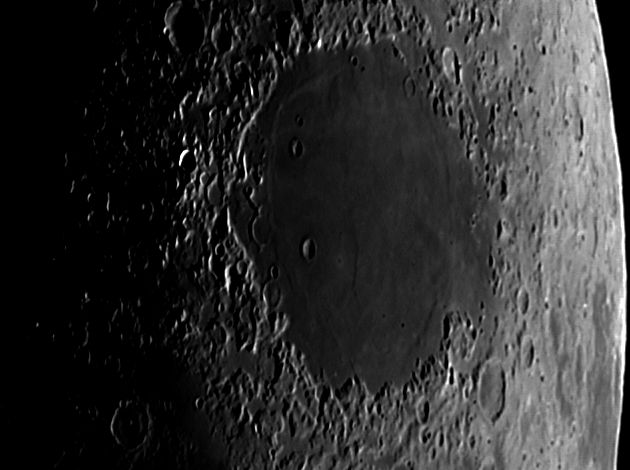
|
This is exactly the same picture as above, but I have reduced the gamma to darken the picture and
bring out the dark patches on the eastern limb. Mare Marginis (the Sea on the Margin) is a non-circular
feature measuring approximately 370 Km east-west and 160 Km north-south and is only seen when the libration
is favourable. The feature to its west was named unofficially Lacus Risus Felis by
Charles Wood in his book The Modern Moon in reference to the Cheshire Cat in Alice in Wonderland
of which I am a great fan. The name translates as The Lake of the Cat's Smile, a reference to the
ability of the Cheshire Cat to fade from view until only it's grin was visible. If you look
carefully, with some imagination, the three dark patches look like two eyes and a broad mouth. Maybe
I can help to perpetuate the name.
The scale markers are approximately 100 Km north and east.
The picture was taken at 19:01 UT on 14th March 2005 with my EXT125.
|
| Date and Time |
14th March 2005 19:01 UT |
Camera |
ToUcam 740K |
Telescope |
ETX125 at prime focus |
Capture |
K3CCDTools. high gamma, 1/100", 36% gain, 350 frames |
Processing |
Registax. 90 frames stacked. Wavelet 1,2 = 10 |
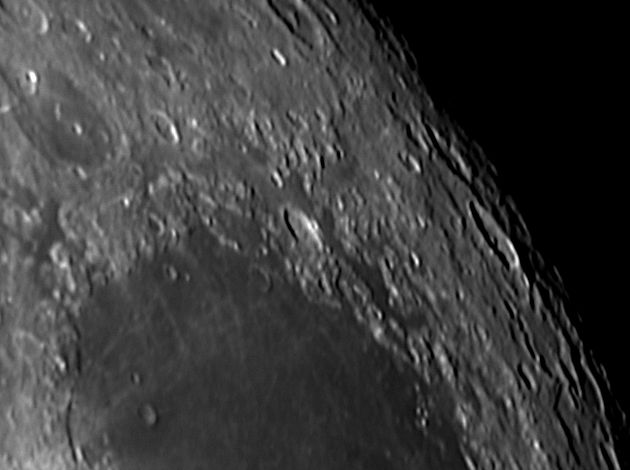
|
I took this picture when the Moon was 15.5 days old to try to resolve the issue of Eimmart from my previous picture. Here the light is from the other side and Eimmart looks fairly typical. I don't know if I have resolved the issue of the straight shadow, but I have no new ideas other than those expressed above. The tiny crater Eimmart A is clearly visible and, although there is no central mountain, the floor of Eimmart looks distinctly rugged, so I can only conclude that the straight shadow at day 4 was caused by the walls of Eimmart A, the shape of the floor, and the perspective.
As with all pictures near the limb, the scale markers are deceptive. They show approximately 100 Km north and east and apply at Eimmart, which is 48 Km in diameter. For comparison, Plutach is also circular and 70 Km in diameter.
Date and Time: 16th November 2005 19:03 UT
Camera: ToUcam 740K
Telescope: LX200 at prime focus
Capture: K3CCDTools. High gamma, 1/250", 17% gain, 604 frames
Processing: Registax. 345 frames stacked. Wavelet 1,2 = 10, histogram 5-200 |
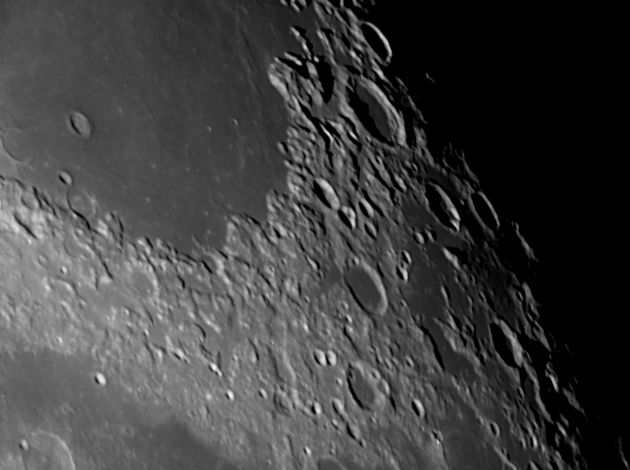
|
The picture above shows the northern half of the Mare Crisium. This picture shows the southern half taken almost a lunar day later.
The scale markers show approximately 100 Km north and east and apply at Firmicus.
Date and Time: 3 February 2007 21:23 UT
Camera: Atik 1-HS
Telescope: LX200 at prime focus
Capture: K3CCDTools. Low gamma, 1/250", 40% gain, 436 frames
Processing: Registax. 12 alignment points, 391 frames stacked. Wavelets 1 = 10, 2 = 5, gamma 1.3 |
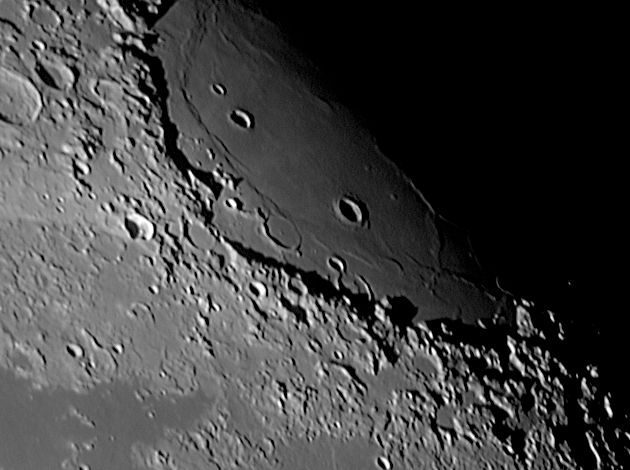
|
This is a picture of the western side of Mare Crisium taken on day 17 so that the Sun is setting over the western part of the mare. This late-evening Sun shows up the Dorsum Oppel. This is part of a ring of wrinkle ridges that typically encircle impact basins. The surface of the mare inside the ring appears to be significantly lower than the outside which resulted from the subsidence of the mare caused by the weight of the lava filling the basin. An interesting crater here is Proclus. This is a very bright and therefor young crater (< 1,000 million years old) and is clearly visible at full Moon along with its principal rays extending roughly south and north-west. These rays, just visible here outlining Palus Somni, indicate that the crater was formed by the impact of a body coming in at a very low angle from the south-west.
Scale markers are approximately 100 Km north and west.
The picture was taken at 23:13 UT on 18th November 2005 when the Moon was 17.6 days old
Date and Time: 18th November 2005 23:13 UT
Camera: ToUcam 740K
Telescope: LX200 at prime focus
Capture: K3CCDTools. high gamma, 1/50", 13% gain, 492 frames
Processing: Registax. 118 frames stacked. Wavelets 1 = 10, 2 = 5, gamma 1.3 |
Home Back to NE Quadrant






